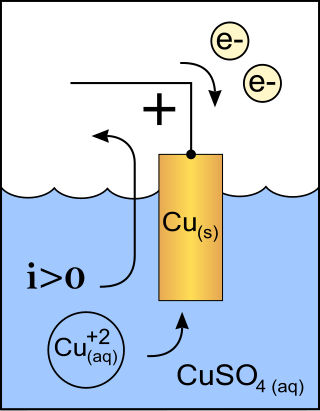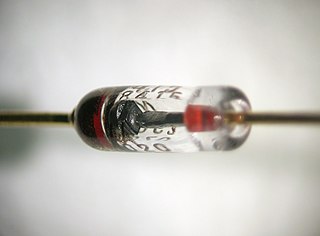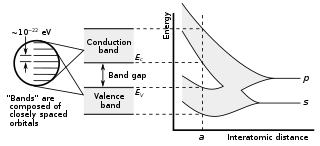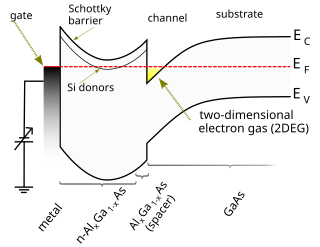Related Research Articles

An electric current is a flow of charged particles, such as electrons or ions, moving through an electrical conductor or space. It is defined as the net rate of flow of electric charge through a surface. The moving particles are called charge carriers, which may be one of several types of particles, depending on the conductor. In electric circuits the charge carriers are often electrons moving through a wire. In semiconductors they can be electrons or holes. In an electrolyte the charge carriers are ions, while in plasma, an ionized gas, they are ions and electrons.

A cathode is the electrode from which a conventional current leaves a polarized electrical device such as a lead-acid battery. This definition can be recalled by using the mnemonic CCD for Cathode Current Departs. A conventional current describes the direction in which positive charges move. Electrons have a negative electrical charge, so the movement of electrons is opposite to that of the conventional current flow. Consequently, the mnemonic cathode current departs also means that electrons flow into the device's cathode from the external circuit. For example, the end of a household battery marked with a + (plus) is the cathode.

A diode is a two-terminal electronic component that conducts current primarily in one direction. It has low resistance in one direction and high resistance in the other.
A semiconductor is a material that is between the conductor and insulator in ability to conduct electrical current. In many cases their conducting properties may be altered in useful ways by introducing impurities ("doping") into the crystal structure. When two differently doped regions exist in the same crystal, a semiconductor junction is created. The behavior of charge carriers, which include electrons, ions, and electron holes, at these junctions is the basis of diodes, transistors, and most modern electronics. Some examples of semiconductors are silicon, germanium, gallium arsenide, and elements near the so-called "metalloid staircase" on the periodic table. After silicon, gallium arsenide is the second-most common semiconductor and is used in laser diodes, solar cells, microwave-frequency integrated circuits, and others. Silicon is a critical element for fabricating most electronic circuits.
Electrical resistivity is a fundamental specific property of a material that measures its electrical resistance or how strongly it resists electric current. A low resistivity indicates a material that readily allows electric current. Resistivity is commonly represented by the Greek letter ρ (rho). The SI unit of electrical resistivity is the ohm-metre (Ω⋅m). For example, if a 1 m3 solid cube of material has sheet contacts on two opposite faces, and the resistance between these contacts is 1 Ω, then the resistivity of the material is 1 Ω⋅m.

In solid-state physics and solid-state chemistry, a band gap, also called a bandgap or energy gap, is an energy range in a solid where no electronic states exist. In graphs of the electronic band structure of solids, the band gap refers to the energy difference between the top of the valence band and the bottom of the conduction band in insulators and semiconductors. It is the energy required to promote an electron from the valence band to the conduction band. The resulting conduction-band electron are free to move within the crystal lattice and serve as charge carriers to conduct electric current. It is closely related to the HOMO/LUMO gap in chemistry. If the valence band is completely full and the conduction band is completely empty, then electrons cannot move within the solid because there are no available states. If the electrons are not free to move within the crystal lattice, then there is no generated current due to no net charge carrier mobility. However, if some electrons transfer from the valence band to the conduction band, then current can flow. Therefore, the band gap is a major factor determining the electrical conductivity of a solid. Substances having large band gaps are generally insulators, those with small band gaps are semiconductors, and conductors either have very small band gaps or none, because the valence and conduction bands overlap to form a continuous band.

In physics, chemistry, and electronic engineering, an electron hole is a quasiparticle denoting the lack of an electron at a position where one could exist in an atom or atomic lattice. Since in a normal atom or crystal lattice the negative charge of the electrons is balanced by the positive charge of the atomic nuclei, the absence of an electron leaves a net positive charge at the hole's location.

In physics and electrical engineering, a conductor is an object or type of material that allows the flow of charge in one or more directions. Materials made of metal are common electrical conductors. The flow of negatively charged electrons generates electric current, positively charged holes, and positive or negative ions in some cases.

A p–n junction is a combination of two types of semiconductor materials, p-type and n-type, in a single crystal. The "n" (negative) side contains freely-moving electrons, while the "p" (positive) side contains freely-moving electron holes. Connecting the two materials causes creation of a depletion region near the boundary, as the free electrons fill the available holes, which in turn allows electric current to pass through the junction only in one direction.

A high-electron-mobility transistor, also known as heterostructure FET (HFET) or modulation-doped FET (MODFET), is a field-effect transistor incorporating a junction between two materials with different band gaps as the channel instead of a doped region. A commonly used material combination is GaAs with AlGaAs, though there is wide variation, dependent on the application of the device. Devices incorporating more indium generally show better high-frequency performance, while in recent years, gallium nitride HEMTs have attracted attention due to their high-power performance.
In semiconductor production, doping is the intentional introduction of impurities into an intrinsic (undoped) semiconductor for the purpose of modulating its electrical, optical and structural properties. The doped material is referred to as an extrinsic semiconductor.
In semiconductor physics, the depletion region, also called depletion layer, depletion zone, junction region, space charge region, or space charge layer, is an insulating region within a conductive, doped semiconductor material where the mobile charge carriers have diffused away, or been forced away by an electric field. The only elements left in the depletion region are ionized donor or acceptor impurities. This region of uncovered positive and negative ions is called the depletion region due to the depletion of carriers in this region, leaving none to carry a current. Understanding the depletion region is key to explaining modern semiconductor electronics: diodes, bipolar junction transistors, field-effect transistors, and variable capacitance diodes all rely on depletion region phenomena.
Deep-level traps or deep-level defects are a generally undesirable type of electronic defect in semiconductors. They are "deep" in the sense that the energy required to remove an electron or hole from the trap to the valence or conduction band is much larger than the characteristic thermal energy kT, where k is the Boltzmann constant and T is the temperature. Deep traps interfere with more useful types of doping by compensating the dominant charge carrier type, annihilating either free electrons or electron holes depending on which is more prevalent. They also directly interfere with the operation of transistors, light-emitting diodes and other electronic and opto-electronic devices, by offering an intermediate state inside the band gap. Deep-level traps shorten the non-radiative life time of charge carriers, and—through the Shockley–Read–Hall (SRH) process—facilitate recombination of minority carriers, having adverse effects on the semiconductor device performance. Hence, deep-level traps are not appreciated in many opto-electronic devices as it may lead to poor efficiency and reasonably large delay in response.
In solid-state physics of semiconductors, carrier generation and carrier recombination are processes by which mobile charge carriers are created and eliminated. Carrier generation and recombination processes are fundamental to the operation of many optoelectronic semiconductor devices, such as photodiodes, light-emitting diodes and laser diodes. They are also critical to a full analysis of p-n junction devices such as bipolar junction transistors and p-n junction diodes.

Mott insulators are a class of materials that are expected to conduct electricity according to conventional band theories, but turn out to be insulators. These insulators fail to be correctly described by band theories of solids due to their strong electron–electron interactions, which are not considered in conventional band theory. A Mott transition is a transition from a metal to an insulator, driven by the strong interactions between electrons. One of the simplest models that can capture Mott transition is the Hubbard model.
Hot carrier injection (HCI) is a phenomenon in solid-state electronic devices where an electron or a “hole” gains sufficient kinetic energy to overcome a potential barrier necessary to break an interface state. The term "hot" refers to the effective temperature used to model carrier density, not to the overall temperature of the device. Since the charge carriers can become trapped in the gate dielectric of a MOS transistor, the switching characteristics of the transistor can be permanently changed. Hot-carrier injection is one of the mechanisms that adversely affects the reliability of semiconductors of solid-state devices.
An extrinsic semiconductor is one that has been doped; during manufacture of the semiconductor crystal a trace element or chemical called a doping agent has been incorporated chemically into the crystal, for the purpose of giving it different electrical properties than the pure semiconductor crystal, which is called an intrinsic semiconductor. In an extrinsic semiconductor it is these foreign dopant atoms in the crystal lattice that mainly provide the charge carriers which carry electric current through the crystal. The doping agents used are of two types, resulting in two types of extrinsic semiconductor. An electron donor dopant is an atom which, when incorporated in the crystal, releases a mobile conduction electron into the crystal lattice. An extrinsic semiconductor that has been doped with electron donor atoms is called an n-type semiconductor, because the majority of charge carriers in the crystal are negative electrons. An electron acceptor dopant is an atom which accepts an electron from the lattice, creating a vacancy where an electron should be called a hole which can move through the crystal like a positively charged particle. An extrinsic semiconductor which has been doped with electron acceptor atoms is called a p-type semiconductor, because the majority of charge carriers in the crystal are positive holes.
A definition in semiconductor physics, carrier lifetime is defined as the average time it takes for a minority carrier to recombine. The process through which this is done is typically known as minority carrier recombination.
A degenerate semiconductor is a semiconductor with such a high level of doping that the material starts to act more like a metal than a semiconductor. Unlike non-degenerate semiconductors, these kinds of semiconductor do not obey the law of mass action, which relates intrinsic carrier concentration with temperature and bandgap.
In solid-state physics, band bending refers to the process in which the electronic band structure in a material curves up or down near a junction or interface. It does not involve any physical (spatial) bending. When the electrochemical potential of the free charge carriers around an interface of a semiconductor is dissimilar, charge carriers are transferred between the two materials until an equilibrium state is reached whereby the potential difference vanishes. The band bending concept was first developed in 1938 when Mott, Davidov and Schottky all published theories of the rectifying effect of metal-semiconductor contacts. The use of semiconductor junctions sparked the computer revolution in the second half of the 20th century. Devices such as the diode, the transistor, the photocell and many more play crucial roles in technology.
References
- ↑ Dharan, Gokul; Stenhouse, Kailyn; Donev, Jason (May 11, 2018). "Energy Education - Charge carrier" . Retrieved April 30, 2021.
- ↑ "Charge carrier". The Great Soviet Encyclopedia 3rd Edition. (1970-1979).
- ↑ Nave, R. "Microscopic View of Electric Current" . Retrieved April 30, 2021.
- ↑ Nave, R. "Conductors and Insulators" . Retrieved April 30, 2021.
- ↑ Fitzpatrick, Richard (February 2, 2002). "Conduction electrons in a metal" . Retrieved April 30, 2021.
- 1 2 "Conductors-Insulators-Semiconductors" . Retrieved April 30, 2021.
- ↑ Steward, Karen (August 15, 2019). "Cation vs Anion: Definition, Chart and the Periodic Table" . Retrieved April 30, 2021.
- ↑ Ramesh Suvvada (1996). "Lecture 12: Proton Conduction, Stoichiometry". University of Illinois at Urbana–Champaign. Archived from the original on May 15, 2021. Retrieved April 30, 2021.
- ↑ Souček, Pavel (October 24, 2011). "Plasma conductivity and diffusion" (PDF). Retrieved April 30, 2021.
- ↑ Alba, Michael (January 19, 2018). "Vacuum Tubes: The World Before Transistors" . Retrieved April 30, 2020.
- ↑ "Cathode Rays | Introduction to Chemistry" . Retrieved April 30, 2021.
- ↑ Nave, R. "Intrinsic Semiconductors" . Retrieved May 1, 2021.
- ↑ Van Zeghbroeck, B. (2011). "Carrier recombination and generation". Archived from the original on May 1, 2021. Retrieved May 1, 2021.
- ↑ del Alamo, Jesús (February 12, 2007). "Lecture 4 - Carrier generation and recombination" (PDF). MIT Open CourseWare, Massachusetts Institute of Technology. p. 3. Retrieved May 2, 2021.
- ↑ "Majority and minority charge carriers" . Retrieved May 2, 2021.
- ↑ Nave, R. "Doped Semiconductors" . Retrieved May 1, 2021.
- ↑ Smith, J. S. "Lecture 21: BJTs" (PDF). Retrieved May 2, 2021.
- ↑ Tulbure, Dan (February 22, 2007). "Back to the basics of power MOSFETs". EE Times. Retrieved May 2, 2021.
- ↑ Van Zeghbroeck, B. (2011). "Carrier densities" . Retrieved July 28, 2022.